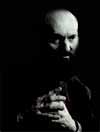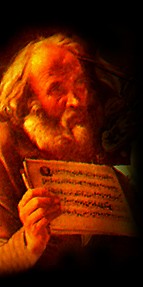 |
 |
 |
 |
 |
|
Longing for Home
An Estonian in his early fifties, Arvo Pärt's life as a composer has been alternating between periods of withdrawal in the search for a style and periods of considerable output of orchestra works in the sixties. After a long period of self-imposed silence he was creatively reborn when first " exposed " to plainchant and the spirituality of the Eastern Church.
This was a discovery of spiritual identity, for all Pärt's music, whether or not it is liturgical, is concerned with the numinous. The vocal pieces are overtly ecclesiastical; the instrumental works seek the eternal silence at the heart of sound, as is indicated by the title of his best known piece, Tabula rasa. If one tries to think of points of reference in defining the nature of Pärt's music one might mention, in addition to plainsong and medieval heterophony, the liturgical music of Stravinsky, Satie's Socrate, and occasionally the ceremonial music of Janácek. But this does not mean that Pärt is influenced by these or any other composers; still less does his work have anything in common - apart from the obvious fact that he uses few notes and much repetition - with the minimalists with whom he is sometimes allied.
The difference lies in the fact that Pärt's few notes are intimately expressive, and therefore in content not minimal at all. A five-minute threnody in memory of Britten, scored for a single bell and strings,
starts from God's music of the bell's overtones and swells, bell-like, into multiple interwining canons that function magically in palliating the finality of death. Having that purity of spirit which Pärt admires in Britten's music, the radiant serenity of both composers always has human relevance.
Arvo Pärt's spiritual awakening is inseparable from his awakening to what he came to consider the ultimate verities of music. In medieval plainsong and organum, Pärt found musics which were, of their nature, in the Western sense non-harmonic. Such monody and heterophony imply a different notion of what music is " about "and "for". His music not only has affinities with medieval liturgical cantillation, but also with sundry ritualistic concepts typical of folk and ethnic cultures. Of course this had happened before - not merely in an eccentric figure like Janácek, but to a degree in the centric Bartók and Stravinsky. What distinguishes Pärt from these composers in the singular purity of his response. He is remarkable precisely because he has found it necessary, and possible, to pare away so much, making what is left more "meaningful" the more exiguous it has become.
 The first brief piece on this album delineates the conditions under which Pärt's music lives, moves and has its being. Arbos is not so much musical communication as musical fiesta, wherein we are released from chronological time and re-enter mythological time in which (as Octavio Paz has put it) "time is not succession and transition but the perpetual sound of the fixed present in which all times, past and future, are contained". Arbos is a state of being: grand, hieratic, static in its minimal, modal, often pentatomic patter-making, sonorous in brass and reverberating in bells and gongs. The music does not modulate and has no development, though pitch and tempo are in proportional relationships, creating "moments" outside Time in which, momently, we live.
The first brief piece on this album delineates the conditions under which Pärt's music lives, moves and has its being. Arbos is not so much musical communication as musical fiesta, wherein we are released from chronological time and re-enter mythological time in which (as Octavio Paz has put it) "time is not succession and transition but the perpetual sound of the fixed present in which all times, past and future, are contained". Arbos is a state of being: grand, hieratic, static in its minimal, modal, often pentatomic patter-making, sonorous in brass and reverberating in bells and gongs. The music does not modulate and has no development, though pitch and tempo are in proportional relationships, creating "moments" outside Time in which, momently, we live.
The other instrumental piece - Pari intervallo for organ - effects the same atemporal process in abstract terms. Here pitch relationships aurally " incarnate" the Moment outside time. Even so, it is significant that the work carries a verbal, biblical epigraph from St. Paul's Epistle to the Romans, and all Pärts music has human and often liturgical "content". An den Eassern zu Babel, scored for four solo voices and organ, is a setting of the famous Waters of Babylon passage from Psalm 137. The weeping and wailing by the waters have evoked response in many twentieth century composers, who are surprisingly aware that modern man has plenty to wail about. The core of the music is the simplest pentatonic or heptatonic monody that proliferates into two, three and four voices. Pedal notes on organ or softly sustained triads provide timeless drones around which melodies undulate, usually by whole tones, sometimes in open arpeggiated figures.
There is virtually no harmonic evolution, though bell-like dissonant clashes occasionally occur between the undulations and drones.
From such unassuming beginnings, a mysterious grandeur flowers.
Though the music gets louder as well as grander, there is no climax; since progression and resolution are extraneous to it, the piece abruptly stops. The human feeling is potent, but is liberated from self-love by Pärt's innocence: a fact which -helps us to understand why he admires the music of Benjamin Britten. The " instanteneous" precision of Britten's sophisticated technique is in a profound sense child-like - not merely when he is composing his magical music for children.
The same qualities distinguish Pärt's setting of the De Profundis (Psalm 130) for four solo voices, organ and percussion. Although the piece, prompted by the words, is wilder than the babylonian lamentation, it offers no desperately personalized yell from the abyss. An immensely slow ostinato-pattern on organ makes the abyss audible; from within in the basso profundo cavernously chants like a Tibetan monk. Melodic lines consist mainly of stepwise movement around static points, unfolding in pendulum-like continuity, involving voice and body in ritualistic gestures that gradually acquire affirmative power. Thus without revolt or cry, we survive our dark night of the soul, until the slow-tolling bells fade into eternity, whence they came.
The major work on the record - the Stabat Mater for a trio of voices and a trio of violin, viola and cello - lasts nearly twenty-five minutes, but is no less static in concept than the short works. The highly stylized, hieratic Latin poem lends itself readily to Pärt's static rondo principle. Immensely distant, the strings emerge out of the void, in a slow-swinging undulation. Melodic lines droop of their own weight, by step, emulating the tears of the Mother at the Cross - and closely resembling the tearful stepwise descents in Pärt's wonderously beautiful threnody for Britten. The first entry of the voices is electrifying; from monody is generated lucidly spaced polyphony, or sometimes heterophony. Each time the rondo-alternations of voices and strings recur they are unsubjected to internal metamorphoses: an aural synonym for the process of medieval alchemy.
The Stabat Mater is Pärt's biggest work apart from the Te Deum and the St. John Passion which, although it tells its story dramatically, does so by means of the same musicalritualistic techniques as the Stabat Mater. An affinity between Pärt's St. John Passion and the Passions of the aged Schütz has been justifiably noted, since both make little attempt to illustrate events narratively, and archive intense expressivity without resort to operatically declamatory rhetoric. Schütz wrung those austerely annealing Passions from the hell of Germany's Thirty Years War - a conflict possibly more horrendous in its effects than any war before our ostensibly enlightened century. Similarly, Pärt's Stabat Mater, no less than his St. John Passion, owes its purgatorial power to its having been created in a world more than usually lacerated by the criminal imbecilities of the human race - in which, of course, we must include ourselves.
Although it may seem that the religious, perhaps mystical, nature of Pärt's experience must render it remote from many, even most, people in an age of unfaith, one recognizes that his innocence, like Britten's, is a quality that anyone may vicariously share in. For Pärt's experience must render it remote from many, even most, people in an age of unfaith, one recognizes that his innocence, like Britten's, is a quality that anyone may vicariously share in. For Pärt's music to work its magic one needs only to be, as the Prayer Book puts it, of good will; certainly magic occurs in his Summa, a setting for four solo voices of the Latin version of the Creed. Again, the music does not attempt directly to illustrate or even express the words: in which it resembles medieval music and is distinct from a Renaissance polyphonist like Byrd, even when he's writing liturgically. Again, there is no modulation and scarcely any shift in modality. The magic lies in the haunting memorability of the tune, undulating between stepwise movement and wide-eyed arpeggiated figures, and in the hypnotic rhythm: which bears us on its gentle current, as it was in the beginning, is now and ever shall be, world without end. After a tune of such vulnerable wonderment the empty fifth at the end really does sound like the eternity of God - of which, during the Middle Ages, it had been a symbol.
The only vocal work that is not overtly religious is the setting of the lyric Es sang vor langen Jahren, by the German Romantic poet Clemens Brentano (1778-1842), scored for alto voice, violin and viola. If not formally religious, however, the piece might claim to be mystical in counter-pointing the human lover's song with the super-natural song of the nightingale, which affords intimations of immortality. This music, at once wistful and consolatory, gives intimation now of a folksong, now of a folksong, now of religious incantation, now of a children's tune, now of a troubadour melody.
The strange poignancy of this small work may come from the way in which it thus fuses most aspects of the Pärttian sensibility. Like so much of Britten, it is Edenic music, the burden of which is close to that at the verse of Henry Vaughan, poet of seventeenth century Britain: who reminded us that
Man in those early dayes
Was not all stone, and Earth,
He shin'd a little, and by those weak Rayes
Had some glimpse of his birth.
He saw Heaven o'er his head, and knew from whence
He came (condemned) hither...
This made him long for home,
As loath to stay with Murmurers, and foes.
Those words were written during the dark days of Britain's civil war of which Vaughan remarked, in a letter to a friend: You see what sort of a Man I have grown into, but in order that you should be well-informed about the Times in which I lived, let me tell you that they were Cruel. For Vaughan and Schütz in the seventeenth century, for Britten and Pärt in the twentieth, the state we call Eden is not evasion but a condition for survival. Because Pärt offers us, from time to time, some glimpse of our Edenic birth we may hazard that his apparently unpretentious, non-demonstrative music will matter the more the older and wearier our marvel-making but in many ways grossly misguided Western world may grow. As he helps us to long for home Murmurers and foes may be - momentarly - discounted.
Wilfrid Mellers
ecm records
|
|
|
|

